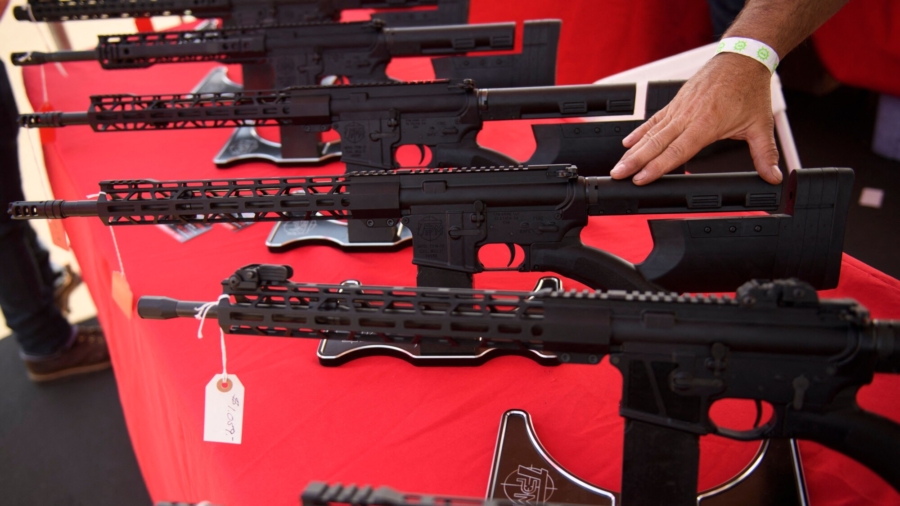People interested in buying certain semiautomatic firearms could be priced out of the market under a new bill supported by more than two dozen Democrats.
On Friday, Rep. Don Beyer (D-Va.) introduced legislation that would impose a 1,000 percent excise tax on purchases of “assault weapons” and “large capacity ammunition feeding devices.” The excise tax means that someone looking to purchase a $500 rifle, for example, would have to pay an extra $5,000 on top of the purchase price.
Twenty-four other Democrat lawmakers co-sponsored the bill, though Mr. Beyer has yet to submit language for the bill.
The forthcoming bill language could follow the same template as a bill Mr. Beyer proposed last year, which he called the “Assault Weapons Excise Act.” Last year’s proposal followed the same premise of imposing a 1,000 percent tax on purchases of “assault weapons” and “large capacity ammunition feeding devices.”
Federal law already imposes a 10 to 11 percent excise tax on all gun purchases.
2022 Bill
Mr. Beyer’s 2022 bill defined “large capacity ammunition feeding devices” as those made or capable of being modified to hold more than 10 rounds of ammunition. “Assault weapons” under the 2022 bill included semi-automatic rifles with an adjustable stock, pistol grip, forward grip, threaded barrel, or functional grenade launcher that is also capable of accepting a detachable magazine, or a semi-automatic rifle with a fixed magazine capable of holding more than 10 rounds of ammunition. This language would encompass widely owned semi-automatic rifles like the AR-15.
A semi-automatic pistol that can accept a detachable magazine and has a threaded barrel, barrel shroud, second pistol grip, the ability to accept a magazine at any point other than the pistol grip, that weighs more than 50 ounces, or includes a stabilizing brace or protruding buffer tube is also considered an “assault weapon” under the 2022 bill, as is a pistol with a fixed-magazine with a capacity greater than 10 rounds.
A semi-automatic shotgun with a fixed magazine capacity greater than five rounds or the ability to accept a detachable magazine, that also has a grip or adjustable stock, is also deemed an “assault weapon” in the 2022 bill.
Mr. Beyer proposed the 2022 “Assault Weapons Excise Act” as a means of circumventing Republican opposition to outright bans on weapons like the kind his bill described.
“I have voted in the past for commonsense gun safety reforms only to see them run aground on Senate Republicans’ filibuster; my bill presents a pathway to bypass that obstruction and enact lifesaving measures,” Mr. Beyer said at the time.
The 2022 bill never made it past the introductory stage, despite Mr. Beyer’s fellow Democrats holding a majority that year. This latest attempt to impose a prohibitive excise tax could face even tougher odds since Republicans took the majority in the House of Representatives after the 2022 midterms.
NTD News reached out to Mr. Beyer’s office for comment but did not receive a reply by the time this article was published.
Gun Rights Activists Decry Excise Tax Plans
Mr. Beyer isn’t the only lawmaker to propose raising excise taxes on gun and ammunition purchases. State lawmakers have proposed similar ideas in California and Connecticut.
In 2019, Democratic New Jersey Gov. Phil Murphy also called for imposing an excise tax on gun and ammunition purchases, while also increasing licensing fees. Mr. Murphy’s call for a 2.5 percent excise on gun purchases was met with criticism from the National Rifle Association (NRA).
“These anti-gun taxes would hit low-income residents the hardest, predictably pricing many of them out of the gun market entirely, even though they typically live in the state’s highest crime areas,” the NRA said of Mr. Murphy’s proposals.
After Mr. Beyer introduced his 2022 bill, the National Association for Gun Rights (NAGR) raised similar concerns about everyday citizens being priced out of the market for their self-defense.
“These people who have the money to be protected by men with guns just want to price out the little guys,” NAGR Deputy Director for Political Operations Ryan Fraser said in an August 2022 podcast. “What’s a normal [AR-15] these days? Between 500 and a grand somewhere? You could go more expensive, you can get cheaper but a $500 AR-15 becomes a $5,500 AR-15, totally pricing out ordinary Americans, small business owners who operate in bad neighborhoods, the single mother with a violent ex-spouse—the people who actually need it.”

